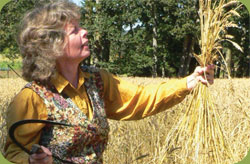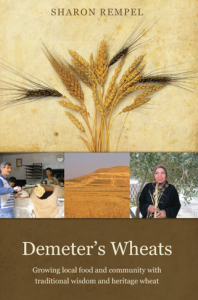 Sharon Rempel advocates for a world that honors cultural traditions, diversity, and abundance, gained through collaboration and caring for each other. She is systems thinker, and wonderful community builder, in ways that acknowledge the historic relationship between people, plant, and place.
Sharon Rempel advocates for a world that honors cultural traditions, diversity, and abundance, gained through collaboration and caring for each other. She is systems thinker, and wonderful community builder, in ways that acknowledge the historic relationship between people, plant, and place.
Sharon is the visionary godmother of today’s Red Fife heritage wheat movement in Canada, founder of Canada’s Seedy Saturday community seed movement, held Canada’s first Bread and Wheat Festival in Victoria in 2007, and currently, is President of The Garden Institute of B.C. Her interest and expertise in wheat has taken her around the world.
I’ve known Sharon for several years, first as a co-music maker at a local Celtic jam session we both attended, and then as someone committed to community building.
Introducing (again!) Red Fife wheat
The wheat was named after David Fife and family, and introduced into Canada, in 1842, from the Ukraine, via Scotland. It was widely popular, and distributed among farmers, throughout the 19th century. Red Fife is considered a landrace, meaning there is genetic variability in the wheat, allowing it to adapt to a diversity of growing conditions, and an ideal companion to those settling new lands.
In the 20th century, the strength of these landraces, their diversity and adaptability, took a back seat to modern wheat varieties (developed from the older landrace/heritage varieties). These modern varieties were usually patented, hybridized, and dependent on chemicals to produce high yields. They were also registered on government-endorsed lists. In the context of export-focused markets, the older landraces, with their natural variability, were considered of lesser value, and often illegal to sell through the main regulatory channels.
From the early 1900s until 1988, Red Fife seed survived only in a few plant breeder collections, and the Canadian Gene Bank. In 1988, Sharon obtained one pound of red fife from the Gene Bank, began growing and promoting Red Fife wheat, to where its re-introduction into the Canadian landscape has taken on the quality of a movement.
Phil Vernon, a Salt Spring Island based community activist, artist and musician, wrote and recorded a great song about Red Fife wheat on his new CD Kitale Road.
The connection to people and place
For Sharon, Red Fife signifies a lost tradition; a tradition exemplified on the Canadian Prairies, of the natural tendency for people to work together and help each other. When people settled the prairies, each town included a grain elevator where people pooled their grain. They built cooperatives, and welcomed cultural diversity, in potlucks, dances, and music. They were tight-knit communities, who learned, survived, and prospered, by working and playing together. Through these practices, Canada developed a strong social fabric of education and medical care. (Canadian public medicine got its start in the Canadian prairies, under Tommy Douglas).
Building communities
And so, Sharon builds on the ancient wisdoms, of an understanding of the relationship between people, plant and place, to develop new communities. Her contributions include:
- Heritage Wheat Project a building global (internet) community that shares stories, seeds and a vision of a new type of agri-Culture system (check out seedmap.org for a global mapping perspective on agri-biodiversity)
- Seedy Saturday / Sunday (started in 1989 in Vancouver) where people can come together and share their seeds and stories about the seed varieties. Now spread to communities across Canada and elsewhere, eg UK
- Bread and Wheat Festival � Canada�s first, 2007, Victoria red fife, music, artisan breads, talks, food, community very successful (I was there it was fantastic I hope there will be another, soon!)
I recently read Sharon’s 2008 book, Demeter’s Wheats, a book about growing local food and community with traditional wisdom and heritage wheat.
I gained many insights on reading her book; including: “the hand that holds the seed controls the food supply (local farmers or anonymous corporations?), buying local does not = buying organic, and imagining time as a spiral (opening up the possibility that answers to the future may be somewhere behind us!).
Her book communicates how Red Fife takes on new significance today; whether: as a social marketing phenomenon, as a cause for farmer identity, adding value to the work of chefs across the country, as a tipping point to connecting us with our past…
This book is a great resource for anyone interested in heritage wheat, why diversity is important, ancient wisdom, and the need to break bread together!
And in your community?
More and more, people want to be part of communities that think and act with systems in mind. Heritage wheat, 100-mile diets, cultural celebrations, neighbourhood gatherings are all expressions, in some way or another, of our desire to be connected. What about your community? How is your community celebrating the historic connection between people, plant and place?
If you enjoyed this post, please consider leaving a comment or subscribing to my blog. Thanks, Ben.


What struck me beyond this captivating movement about which I knew nothing is that Red Fife has the trait (“genetic variability in the wheat,
allowing it to adapt to a diversity of growing conditions”)
that us humans would do well to emulate in this roiling economy
and sometimes rootless culture – the capacity to work + play well with people unlike us –
sometime to collaborate to accomplish greater things together
than we could alone –
perhaps the most vital trait, other than one’s top talent,
in this increasingly connected world.
Thank you for this most inspiring and practical post
Kare, thanks for your kind comments, and observations and insight. I like how you identify the potential of diversity, adaption, collaboration… vis-a-vis our “roiling economy and rootless culture”. It makes me think that promoting “community” (albeit in a different form than 19th prairie towns) can really help address both the economy and culture challenges you speak of!
Nice article, Ben.
Thanks for mentioning the song. When I first heard about Red Fife and David Fife, I knew it was a good story, and was happy to write the song to support the work that Sharon and others are doing to strengthen food security at the (wheat)grassroots level!
Ben, you are the first writer to figure out that my work with Red Fife is a social and political statement. The ‘system’ that commoditizes people, seeds (eg. ‘wheat’) and land shows no respect for the diversity of life that is the true Abundance around us. When we can put ‘variety’ and ‘farmer’ identification back into food and when communities realize that they must have seeds that are adapted to their bioregions then ‘food security’ and ‘peace’ will be possible.
When we can bring story, song and music back to the seasonal celebrations of life then we will be bringing ‘culture back to agriculture’ and ‘folk back to food’.
Keep playing your fiddle Ben and keep singing those great songs Phil! Sharon
Sharon, thank you. I’m humbled to think that I’m the first! (Actually, I think you’re being overly generous with that assessment; at the very least Phil Vernon is in the know!). Hopefully, others are acting on your message, as I write, in their own communities. And yes, I will try fit in some fiddling here and there.
Phil, Thanks for connecting here. I’m looking forward to catching your performance (including Red Fife!) later this month in Victoria.
Nice article, very informative. I would like to grow some Red Fife wheat. Can it be in the USA?
Thanks, Anne
Hi Anne,
I asked Sharon Rempel and she wasn’t sure if Red Fife is sold in USA. As she has many wheat/grain contacts in the USA, I suggest you contact her directly for more info (her contact info is listed on the Garden BC website – accessible through my post on Red Fife). Sorry I’m not more helpful! If I become aware of a specific USA distributor/grower I will let you know. Given its a grain, no doubt there are x-border issues. National borders are strange beasts!
My foundation Keremeos ‘Red Fife’ is sold by Bernie Ehnes, http://www.ehnesorganic.com/faith-red-fife.html and he ships all kinds of grains around the world using the proper paperwork. No problem.
The ‘Blais’ strain is around and certainly in the US but don’t cheat the varieties that are a part of your regional wheat heritage. Check out the 4 USDA Wheat handbooks on http://www.seeds.ca/library/ and also Monika Spiller, Whole Grain Connection, 500 W. Middlefield Road #2 Mountain View CA 94043 Telephone: 650 938 2865 e-mail:barmbaker@aol.com
>> http://www.sustainablegrains.org Monika is connected through the USDA to people growing and using heritage wheat. ALHFAM, the organization connecting living history sites can connect you to amazing local resources, too. Sharon http://www.grassrootsolutions.com